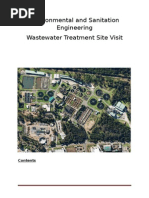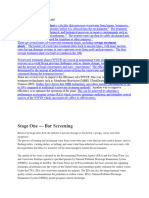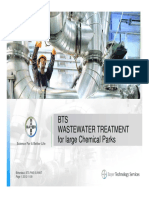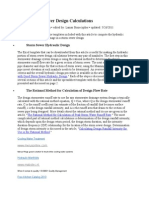Environmental Quality Regulation of 2009 Standard For Industrial Effluent Discharge in Malaysia Standard A B
Environmental Quality Regulation of 2009 Standard For Industrial Effluent Discharge in Malaysia Standard A B
Uploaded by
Leong Kok HuiCopyright:
Available Formats
Environmental Quality Regulation of 2009 Standard For Industrial Effluent Discharge in Malaysia Standard A B
Environmental Quality Regulation of 2009 Standard For Industrial Effluent Discharge in Malaysia Standard A B
Uploaded by
Leong Kok HuiOriginal Description:
Original Title
Copyright
Available Formats
Share this document
Did you find this document useful?
Is this content inappropriate?
Copyright:
Available Formats
Environmental Quality Regulation of 2009 Standard For Industrial Effluent Discharge in Malaysia Standard A B
Environmental Quality Regulation of 2009 Standard For Industrial Effluent Discharge in Malaysia Standard A B
Uploaded by
Leong Kok HuiCopyright:
Available Formats
Environmental Quality Regulation of 2009 Standard for Industrial Effluent Discharge in Malaysia Parameter i. ii. iii. iv. v. vi.
vii. viii. ix. x. xi. xii. xiii. xiv. xv. xvi. xvii. xviii. xix. xx. xxi. xxii. xxiii. xxiv. xxv. xxvi. xxvii. xxviii. xxix. xxx Temperature pH Value BOD5 at 20oC Suspended Solids Mercury Cadmium Chromium, Hexavalent Chromium, Trivalent Arsenic Cyanide Lead Copper Manganese Nickel Tin Zinc Boron Iron (Fe) Silver Aluminium Selenium Barium Fluoride Formaldehyde Phenol Free Chlorine Sulphide Oil and Grease Ammoniacal Nitrogen Colour ADMI* Unit C mg/L mg/L mg/L mg/L mg/L mg/L mg/L mg/L mg/L mg/L mg/L mg/L mg/L mg/L mg/L mg/L mg/L mg/L mg/L mg/L mg/L mg/L mg/L mg/L mg/L mg/L mg/L
o
Standard A 40 6.0-9.0 20 50 0.005 0.01 0.05 0.20 0.05 0.05 0.10 0.20 0.20 0.20 0.20 2.0 1.0 1.0 0.1 10 0.02 1.0 2.0 1.0 0.001 1.0 0.50 1.0 10 100 B 40 5.5-9.0 50 100 0.05 0.02 0.05 1.0 0.10 0.10 0.5 1.0 1.0 1.0 1.0 2.0 4.0 5.0 1.0 15 0.5 2.0 5.0 2.0 1.0 2.0 0.50 10 20 200
*ADMIAmerican Dye Manufacturers Institute
Reference: http://www.mkma.org/Notice%20Board/2010/EnvironmentalRegulation2009.htm
1
WASTEWATER TREATMENT SYSTEM
A. Activated Sludge Process Activated sludge process is a biological wastewater treatment process, involving air or oxygen being introduced into a mixture of wastewater combined with microorganisms to develop a biological floc (clumps of bacteria) which reduces the organic content of the sewage. It is an aerobic process requiring oxygen for treatment. This treatment process is used to oxidize carbonaceous matter (biological matter) and nitrogenous matter (ammonium and nitrogen) besides removing phosphate, driving off entrained gases (carbon dioxide, ammonia, nitrogen, etc), generating a biological floc, and also generating a liquor that is low in dissolved or suspended material.[1] The basic principle is that as microorganisms grow, they form particles that clump together. This biological floc is allowed to settle to the bottom of the tank, leaving a relatively clear liquid that free of organic material and suspended solids.[2] Figure 1 shows the typical activated sludge process.
Figure 1: Typical activated sludge process.
In a basic activated sludge process, it consists of several interrelated major components which included an aeration tank (MLSS), an aeration source, a clarifier, a mean of return activated sludge (RAS) and a mean of waste activated sludge (WAS).[2] Table 1 shows the function of the major components in a typical activated sludge process whereas Figure 2 shows the flow diagram of the activated sludge process.
Table 1: The function of the major components in a typical activated sludge process. No. 1 2 3 4 5 Typical Activated Sludge Process Major Components Function Provides an environment for the occurring of Aeration tank (MLSS) biological reactions. Aeration Source Provides air or oxygen and mixing. Settles and separates solid from the treated Clarifier wastewater. Return Activated Sludge (RAS) Returns solid to the aeration tank. Waste Activated Sludge (WAS) Removes solid from the activated sludge process.
Figure 2: Flow diagram of the activated sludge process.
According to the flow diagram, the bar rack coarse solids such as sticks, rags, and other debris in untreated wastewater are removed by the interception. By the use of fine screenings, those floatable matter and algae are also removed. In the grit chamber, grit is removed consisting of sand, gravel, cinders, or other heavy solid materials that have subsiding velocities or specific gravities substantially greater than those of the organic solids in wastewater. The primary clarifier is a basin where water has a certain retention time where the heavy suspended organic solids can be sediment. The influent of the aeration tank is mixed with activated sludge. In the aeration tank, the mixed liquor is aerated. By aerating the mixed liquor, the aerobic processes will be stimulated, the growth rate of bacteria will be faster. As the bacteria deplete the substrate, flocculation takes place. The soluble substrate becomes a solid biomass. These flocks of biomass will sediment in the secondary clarifier. At the end of the activated sludge process, the effluent water is treated to disinfect it and make it free of disease-causing organisms.[3]
While many activated sludge treatment works have been built in developing countries, very few work as well as intended. Activated sludge can be appropriate where high removal of organic pollution is required, funds and skilled personnel are available for operation and maintenance, and land is scarce or expensive. Since activated sludge requires the continuous operation of oxygen blowers and sludge pumps, a steady energy supply is a key requirement. Besides, other considerations for the general designation of
3
activated sludge process included wastewater characteristics, local environmental conditions (including temperature), possible presence of toxic or other inhibitory substances (will the process receive industrial effluents or septage, for instance), oxygen transfer requirements and reaction kinetics (detention time in the system, related to quality and quantity of wastewater received, effluent requirements, sludge treatment requirements and other factors listed above).[4] Table 2 shows the advantages and disadvantages of the activated sludge process.
Table 2: Advantages and disadvantages of the activated sludge process. Activated Sludge Process Advantages Disadvantages Efficient removal of BOD, COD and Expensive in terms of both capital and nutrients. operation and maintenance (O&M) cost. Needs trained operator for monitoring and reacting to the system changes High Flexibility immediately. Can be modified based on local The needs of availability of spare parts requirements. and chemicals.
References: 1. 2. 3. 4. http://en.wikipedia.org/wiki/Activated_sludge http://www.nesc.wvu.edu/pdf/ww/publications/pipline/pl_sp03.pdf http://www.lenntech.com/wwtp/wwtp-overview.htm http://water.worldbank.org/water/shw-resource-guide/infrastructure/menu-technicaloptions/activated-sludge
B. Trickling Filters
A trickling filter is a process that converts dissolved and colloidal waste material into solids. Trickling filters flow into clarifiers or settling tanks where the solid separation takes place. The trickling filter utilizes slime producing organisms to convert liquid wastes into solid form. Slime growth is one of the main functions of a trickling filter. The slime is also called bio-mass or microbial layer. Finally, they are called sludge when the solids are disposed.
A Trickling filters originally were rock beds where liquid waste sewage was irrigated or distributed onto the rock media. Undoubtedly, the early trickling filters were modeled after natures rocky streambeds. The trickling filter is in essence a mechanical copy of natures process to clean up waste in a healthy flowing stream. When properly designed and operated, the trickling filter removes much higher waste loads more efficiently than would naturally occur in a streambed. The trickling filter is a highly efficient means of purifying water or converting dissolved and colloidal wastes into separable solids. In order to obtain high removal efficiencies, it is critical that certain classes of organisms grow in the microbial layer of a trickling filter. Management of the trickling filter is a key job for the treatment plant operator so that a proper type of microbial layer is produced and maintained. Overall, the microbial layer requires the proper amount of oxygen, water, and harvesting in order to produce the most efficient waste removal rates. When the best organisms are grown in the microbial layer, the sludge produced when the microbial layer slough settles well, reasonably quickly, and it flocculates well .A well-flocculated sludge helps filter small particles and colloidal solids out of the liquid.[1] Table 1 shows the advantages and disadvantages of the trickling filters. Figure 1 shows the flow diagram of trickling filter.
Table 1 : Advantages and disadvantages of the trickling filters.[2] Trickling Filters Advantages Low Energy Requirements. Waste Sludge Easy to Dewater. Low Maintenance Requirement. Consistent Effluent Quality. Resistant to Toxins and Shock Load. Ease of Operation. Disadvantages Odors and Nuisance Organisms. Potential for Clogged Media. Cold Weather Can Cause Freezing. Lack of Adjustment High Pumping Costs.
Figure 1: Flow Diagram of the Trickling filter.
The beginning of the trickling filter treatment process is like treatment in a packaged plant. The wastewater passes through a bar screen, a grit screen, a comminutor, and a primary clarifier. Sludge from the primary clarifier goes to the digester while the mostly liquid portion of the wastewater goes on to the trickling filter. The liquid portion of the B.O.D. and ammonia from the clarifier, as well as the supernatant from the digester, are pumped to the trickling filter. Both the B.O.D. and the ammonia are required to produce the right growth of microorganisms on the media to provide good treatment. The liquid influent is piped to the spray heads at the top of the trickling filter. The force of the water causes the spray heads to rotate above the media, acting like a sprinkler and evenly distributing water across the media. The influent trickles down through the media. The media is covered with a slime of both aerobic and anaerobic microorganisms. These microorganisms remove the organic matter from the water. As the water passed through the trickling filter, some of the slime was sloughed off of the filter bed. In addition, there is still some sludge in the wastewater. These solids are removed when the water flows from the trickling filter through the secondary clarifier. The solids from the clarifier are sent to the digester. The supernate from the clarifier (now called effluent) is sent in two directions. Some of the supernate is re-circulated through the trickling filter to reduce the B.O.D. loading by watering down the influent. The rest of the clarifier's supernate is chlorinated and de-chlorinated or passed through a UV light. This disinfection process helps wipe out most of the microorganisms and the coliform bacteria. The final part of the treatment process is the step aerator. As the effluent flows over the step aerator, the dissolved oxygen levels are increased.[3] Figure 2 shows the major components of trickling filter whereas Table 2 shows the function of major components of trickling filter.
Figure 2: The major components of Trickling Filter.
Table 2: The function of major components of Trickling Filter.[4] No. Major Component 1 Structured-Sheet Plastic Media 2 3 4 5 Trickling Filters Function Provide an filter space for the microbial formation. Media Support System Supports media and allows air ventilation. Domes & Forced-Draft Ventilation Reduce temperature losses and shield the system from interfering with ventilation. Rotating-Arm Distributor Distributes the mixed wastewater/recycled water over the top of the media. Recycle Pump Recycle the wastewater or discharged to a secondary clarifier.
References: 1. 2. 3. 4. http://www.waterworldce.com/courses/31/pdf/trickling.pdf http://www.padepelearn.com/resources/modules/ww/ww20_trickling_filter_wb.pdf http://water.me.vccs.edu/concepts/trickling.html http://www.brentwood-ind.com/water/pdfs/tfda.pdf
C. Oxidation Pond
Oxidation Ponds are also known as stabilization ponds or lagoons. They are used for simple secondary treatment of sewage effluents. Within an oxidation pond heterotrophic bacteria degrade organic matter in the sewage which results in production of cellular material and minerals. The production of these supports the growth of algae in the oxidation pond. Growth of algal populations allows further decomposition of the organic matter by producing oxygen. The production of this oxygen replenishes the oxygen used by the heterotrophic bacteria. Typically oxidation ponds need to be less than 10 feet deep in order to support the algal growth. In addition, the use of oxidation ponds is largely restricted to warmer climate regions because they are strongly influenced by seasonal temperature changes. Oxidation ponds also tend to fill, due to the settling of the bacterial and algal cells formed during the decomposition of the sewage. Overall, oxidation ponds tend to be inefficient and require large holding capacities and long retention times. The degradation is relatively slow and the effluents containing the oxidized products need to be periodically removed from the ponds. Figure 1 shows the oxidation pond. Table 1 shows the advantages and disadvantages of oxidation pond.
Figure 1: Oxidation Pond Table 1: Advantages and Disadvantages of Oxidation Pond. Oxidation Pond Advantages Low operational and maintenance cost. Effective treatment with minimal threat to the environment. Work well in clay soils where conventional subsurface on-site absorption fields will not work.
8
Disadvantages Must be constructed in clay soil or be lined to prevent leakage. May overflow occasionally during extended periods of heavy rainfall. Takes up a relatively large space. Potential danger and need to be fenced.
Figure 2: Flow Diagram of Oxidation Pond.
Figure 3: Basic Biological Reaction in an Oxidation Pond. Figure 2 above shows the flow diagram of oxidation pond whereas Figure 3 shows the basic biological reaction in an oxidation pond. According to the information, the primary treated effluent is discharged under the surface of the water to the center of the oxidation pond. This allows even distribution and more effective treatment. Exposure to sunlight and oxygen enables aerobic bacteria to digest organic matter in the effluent. Oxidation ponds are designed to operate with three to five feet of wastewater. The volume is reduced by evaporation. Oxidation ponds should be built in locations where then sunlight does not being blocked. A dike is constructed on all sides of oxidation pond to prevent inflow of surface water and discharge of wastewater. Oxidation ponds should be constructed in clay soil or be lined to prevent leakage. It is designed to have no discharge to the environment and thus it provides effective treatment of wastewater with minimal threat to the environment.[2]
Figure 4: Example of aerator in oxidation ponds. There are several types of method to aerate an oxidation pond, such as Motordriven submerged or floating jet aerators, Motor-driven floating surface aerators, Motordriven fixed-in-place surface aerators, and also Injection of compressed air through submerged diffusers. These major components of oxidation pond, which is aerator, transfer air into the oxidation pond required by the biological oxidation reactions, and also provide the mixing required for dispersing the air and for contacting the reactants. [3]
References: 1. www.rpi.edu/dept/chem-eng/BiotechEnviron/FUNDAMNT/streem/methods.htm 2. http://www.deq.state.ok.us/factsheets/local/Lagoon.pdf 3. http://en.wikipedia.org/wiki/Aerated_lagoon
10
You might also like
- Secondary TreatmentDocument14 pagesSecondary TreatmentNasirNo ratings yet
- Wastewater and Excreta DisposalDocument95 pagesWastewater and Excreta DisposalRyeanKRumanoNo ratings yet
- How Industrial Businesses Can Reduce Production Costs With Reverse Osmosis: Industrial Reverse OsmosisFrom EverandHow Industrial Businesses Can Reduce Production Costs With Reverse Osmosis: Industrial Reverse OsmosisRating: 5 out of 5 stars5/5 (1)
- Settleability Problems and Loss of Solids in the Activated Sludge ProcessFrom EverandSettleability Problems and Loss of Solids in the Activated Sludge ProcessNo ratings yet
- ExamDocument9 pagesExamDileepa NeranjanaNo ratings yet
- WWTP ProcessDocument14 pagesWWTP ProcessShimmer WongNo ratings yet
- Sewage TreatmentDocument5 pagesSewage TreatmentbalachandransheebaNo ratings yet
- Sewage Treatment PlantDocument12 pagesSewage Treatment Plantanuj dhavanNo ratings yet
- Primary Secondary WWT2Document27 pagesPrimary Secondary WWT2Jess RadañaNo ratings yet
- Effluent Treatment PlantDocument67 pagesEffluent Treatment PlantSWATHI ACHARNo ratings yet
- Waste Water TreatmentDocument6 pagesWaste Water Treatmentstylish eagle100% (1)
- Environmental Engineering Lec 4 (Editted Version)Document34 pagesEnvironmental Engineering Lec 4 (Editted Version)yaseen10388No ratings yet
- Activated Sludge Treatment NoteDocument7 pagesActivated Sludge Treatment Notesates3No ratings yet
- Lecture - 3 - Wastewater Treatment - Aerobic and Anaerobic-1Document11 pagesLecture - 3 - Wastewater Treatment - Aerobic and Anaerobic-1negaathanipalanisamyNo ratings yet
- Lesson 15 - Trickling FiltersDocument10 pagesLesson 15 - Trickling FiltersShane RodriguezNo ratings yet
- Finals NotesDocument4 pagesFinals NotescherriebaekkiebbhNo ratings yet
- Activated Sludge Process and Filtration (Wastewater)Document7 pagesActivated Sludge Process and Filtration (Wastewater)ym78900No ratings yet
- AM NotesDocument6 pagesAM Notes060 ADRIEL BraganzaNo ratings yet
- CH - 2 Lecture 3Document30 pagesCH - 2 Lecture 3yimer MohammedNo ratings yet
- Activated Sludge Treatment ProcessDocument7 pagesActivated Sludge Treatment ProcessMaizan Sofia100% (1)
- FINAL WORK - ACTIVATED SLUDGE PROCESSDocument19 pagesFINAL WORK - ACTIVATED SLUDGE PROCESSCRASHEKIA MWAMPASHINo ratings yet
- Environment U 2-1Document25 pagesEnvironment U 2-1Jahanvi SainiNo ratings yet
- Me ReportDocument12 pagesMe ReportUmit AkgulNo ratings yet
- SITE VISIT TO Waste WATER TREATMENT PLANTDocument12 pagesSITE VISIT TO Waste WATER TREATMENT PLANTNajum U Saqib Bhat100% (1)
- EE-2 Mini Project ReportDocument7 pagesEE-2 Mini Project Report63GANESH SINGHCIVIL100% (1)
- Waste Water TreatmentDocument10 pagesWaste Water TreatmentPriyank Lashkari100% (1)
- Anaerobic Digestion For Environmental ProcessesDocument5 pagesAnaerobic Digestion For Environmental ProcessesWONG TSNo ratings yet
- Unt IiiDocument8 pagesUnt IiiBABU RAONo ratings yet
- Waste Water Treatment IEMDocument37 pagesWaste Water Treatment IEMpawan88502No ratings yet
- Water Treatment System-Iit NoteDocument14 pagesWater Treatment System-Iit NoteBhaswar MajumderNo ratings yet
- Effluent TreatmentDocument21 pagesEffluent TreatmentRadhika AnandkumarNo ratings yet
- Report OF Sewage Treatment PlantDocument17 pagesReport OF Sewage Treatment PlantSanand Karwa100% (5)
- Actvated Sludge Process SSWMDocument28 pagesActvated Sludge Process SSWMGREENLAB ECL TECHNo ratings yet
- Waste Water Treatment PlantDocument51 pagesWaste Water Treatment PlantenockelisantemsangiNo ratings yet
- Name: Ferdy Rasyid Syachranie Matric No: 208654: 1. What Is The Function of The Screen?Document3 pagesName: Ferdy Rasyid Syachranie Matric No: 208654: 1. What Is The Function of The Screen?I Am Your Worst NightmareNo ratings yet
- Sewage TreatmentDocument24 pagesSewage TreatmentGemrex Breva100% (1)
- ACTIVATED SLUDGE IN WASTEWATER TREATMENT - Video Clip - 064123Document5 pagesACTIVATED SLUDGE IN WASTEWATER TREATMENT - Video Clip - 064123bcew22-tchizuleNo ratings yet
- Fermentation Technology in Sewage Waste WaterDocument4 pagesFermentation Technology in Sewage Waste Waterfama18No ratings yet
- Waste Water EnggDocument5 pagesWaste Water EnggAarav PaptaNo ratings yet
- Sop STP 02Document5 pagesSop STP 02priyanka.singhNo ratings yet
- Sewage Treatment PlantsDocument8 pagesSewage Treatment PlantsJefferson SmithNo ratings yet
- Wastewater TrainDocument3 pagesWastewater TrainLester Mercado100% (1)
- InternshipDocument18 pagesInternshipShaik Mastan ValiNo ratings yet
- Waste Water ManagementDocument16 pagesWaste Water Managementnimisha joly chennakadanNo ratings yet
- Chapter-1: 1.1 Waste Water Treatment PlantDocument39 pagesChapter-1: 1.1 Waste Water Treatment PlantKalyan Reddy AnuguNo ratings yet
- Waste Water TechniquesDocument6 pagesWaste Water TechniqueschimutovewNo ratings yet
- Enve 300 Staj Raporu-Summer Practice ReportDocument24 pagesEnve 300 Staj Raporu-Summer Practice Reportmihrican302No ratings yet
- Effluent Treatment Basics A Case StudyDocument16 pagesEffluent Treatment Basics A Case Studymuhammad naseemNo ratings yet
- Tet Unit 3 NotesDocument25 pagesTet Unit 3 NotesnesamaniconstructionsNo ratings yet
- Operating A Water Treatment Plant Is Complex and Requires Knowledge of MachineryDocument12 pagesOperating A Water Treatment Plant Is Complex and Requires Knowledge of MachineryJoshua OmolewaNo ratings yet
- Report of Educational VisitDocument5 pagesReport of Educational VisitHARSHADNo ratings yet
- WastewaterDocument12 pagesWastewaterJerome JavierNo ratings yet
- V2i4 1160Document8 pagesV2i4 1160Ajay Kumar GantiNo ratings yet
- Wastewater Treatment Objectives, and Processes: March 2016Document51 pagesWastewater Treatment Objectives, and Processes: March 2016Vaishnavi SrivastavaNo ratings yet
- Compilation of Sewage Treatment Technologies in BangladeshDocument11 pagesCompilation of Sewage Treatment Technologies in BangladeshNaymur RahmanNo ratings yet
- ES Project 3Document4 pagesES Project 3mariumzahid987No ratings yet
- WWTP ReportDocument10 pagesWWTP ReportDeep SinojiyaNo ratings yet
- LEC 5 Use of Microorganisms in Effluent TreatmentDocument5 pagesLEC 5 Use of Microorganisms in Effluent TreatmentDysmas100% (1)
- Effluent Treatment: Basics & A Case StudyDocument15 pagesEffluent Treatment: Basics & A Case StudyRiki MandolNo ratings yet
- Biological Sludge Minimization and Biomaterials/Bioenergy Recovery TechnologiesFrom EverandBiological Sludge Minimization and Biomaterials/Bioenergy Recovery TechnologiesEtienne PaulNo ratings yet
- Micro Project swm-1Document11 pagesMicro Project swm-1adityaahire230No ratings yet
- CDM Composting Project Okhla IndiaDocument2 pagesCDM Composting Project Okhla Indiaguna nand shuklaNo ratings yet
- SEWAGE-DISPOSAL-SYSTEM ppt notesDocument9 pagesSEWAGE-DISPOSAL-SYSTEM ppt notesJamia Nadine HipeNo ratings yet
- Constructed Wetlands Manual - UNDocument102 pagesConstructed Wetlands Manual - UNfotikosNo ratings yet
- MudalipalayamDocument59 pagesMudalipalayamsharan sharanNo ratings yet
- Ethiopia - National - Wash - Cluster PresentationDocument40 pagesEthiopia - National - Wash - Cluster PresentationAmiriraj SNo ratings yet
- Tutorial 2Document3 pagesTutorial 2sudhanshu shekharNo ratings yet
- Brochure Commerciale DGT UkDocument33 pagesBrochure Commerciale DGT UkRahayu HandayaniNo ratings yet
- STP Final Boq-Etp+stpDocument9 pagesSTP Final Boq-Etp+stpT M Murshed MukulNo ratings yet
- Study Guide 1: Earth Science: General InstructionsDocument3 pagesStudy Guide 1: Earth Science: General InstructionsFluffette GamingNo ratings yet
- Bayer Aeration SystemDocument21 pagesBayer Aeration SystemRonaldo LeiteNo ratings yet
- Mlvss Mlss RatioDocument7 pagesMlvss Mlss RatiocassindromeNo ratings yet
- Dilg Reportorial 2019116 - Fc16750a06Document150 pagesDilg Reportorial 2019116 - Fc16750a06Lowela Abogadie100% (1)
- NotesDocument5 pagesNotesVaishnavi DappureNo ratings yet
- Development Costs: Clackamas CountyDocument6 pagesDevelopment Costs: Clackamas Countypriyanshi SharmaNo ratings yet
- Hierarchy of Pakistan Waste ManagementDocument16 pagesHierarchy of Pakistan Waste ManagementAsifa YounasNo ratings yet
- Exam WWTP-STP EtcDocument9 pagesExam WWTP-STP EtcEdward AlfaroNo ratings yet
- Operational Waste Management Plan - Residential Development at Cois Caisleán (Phase 2) Maglin, Ballincollig, CorkDocument12 pagesOperational Waste Management Plan - Residential Development at Cois Caisleán (Phase 2) Maglin, Ballincollig, CorkAnna Ligia DominguesNo ratings yet
- Product-Sheet Filter NDF 03 2017 2Document2 pagesProduct-Sheet Filter NDF 03 2017 2Nduong NguyenNo ratings yet
- Portable Treatment Plant For Institutional Canteen Waste Water ManagementDocument6 pagesPortable Treatment Plant For Institutional Canteen Waste Water ManagementInternational Journal of Innovative Science and Research TechnologyNo ratings yet
- BIOMAG - Community Based Solid Waste Management Through Re-Cycling and Up-Cycling in An Adopted Ward of Corporation of Kochi, Kerala, India.Document8 pagesBIOMAG - Community Based Solid Waste Management Through Re-Cycling and Up-Cycling in An Adopted Ward of Corporation of Kochi, Kerala, India.ajmrdNo ratings yet
- Sewage Disposal. Dr. Benjamin P.L. Ho Department of Mechanical Engineering The University of Hong Kong E-Mail - Benjamin - Ho@hku - HKDocument72 pagesSewage Disposal. Dr. Benjamin P.L. Ho Department of Mechanical Engineering The University of Hong Kong E-Mail - Benjamin - Ho@hku - HKTsz Chung ChanNo ratings yet
- Mini Project ReportDocument5 pagesMini Project ReportSaj BhaiNo ratings yet
- Chapter. 6 - HydrographDocument43 pagesChapter. 6 - HydrographfahadNo ratings yet
- Storm Water Sewer Design CalculationsDocument4 pagesStorm Water Sewer Design CalculationsFazil ZamindarNo ratings yet
- Nonfiction Reading Test GarbageDocument6 pagesNonfiction Reading Test GarbageNancy TamNo ratings yet
- Activated Sludge ProcessDocument53 pagesActivated Sludge ProcessVivek KasarNo ratings yet
- Medieval and Early ModernDocument20 pagesMedieval and Early ModernAlasdair MandsNo ratings yet
- RRR PPT Updated 50000Document16 pagesRRR PPT Updated 50000soura manNo ratings yet

























































































